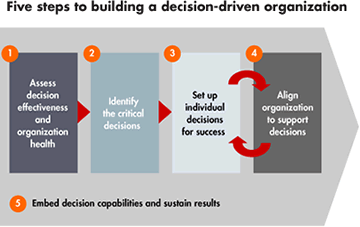Article
Imagine busting your company's bureaucracies, freeing up people and teams so they can actually get things decided and done. Imagine putting an end to "analysis paralysis," internal politics and all the other organizational obstacles to great decision making and execution.
That kind of transformation has helped companies such as ABB and Ford Motor Co. turn themselves around. It has helped MetLife and Hospira pursue ambitious goals of industry leadership. And it has enabled business units such as Intel's Embedded and Communications Group (ECG) to eliminate the kinds of behaviors that employees at many organizations find frustrating. "We're not thrashing around as much," says ECG general manager Doug Davis. "We're not going back to revisit decisions that were already made."
The key to such a transformation is recognizing that decisions drive performance. Companies that systematically analyze and fix how decisions are made and executed improve their results, in part because they liberate the energy and enthusiasm of their people.
In our experience, companies typically follow five steps to become decision-driven organizations:

- Assess your decision effectiveness—and how your organization helps or gets in the way. Using our methodology and research database, companies can determine how they stack up on decision quality, speed, execution and effort. They can pinpoint which parts of the organization are obstacles to performance.
- Identify your critical decisions. Some of an organization's most important decisions are obvious—they're the major strategic choices that involve large investments of resources. Others may be daily operational decisions, such as pricing or customer service, that cumulatively create (or destroy) a lot of value. Underperforming organizations can identify and "X-ray" their critical decisions to understand the trouble spots.
- Redesign individual decisions for success. Applying time-tested practices to critical decisions can bring about dramatic improvements. For example, does everyone understand exactly what the decision is? Are all the roles clear to everybody? Is the necessary information available at the right time? Redesigning a decision not only makes things work better, it reveals the opportunities for more far-reaching change.
- Ensure that the whole organization reinforces great decision making and execution. Ultimately, you want a company in which people handle decisions well as a matter of course. So every organizational element—structure, process, incentives, culture and so on—has to support good decision making and execution. View the organization with decisions in mind and you'll see barriers and potholes that you might otherwise have missed.
- Embed the changes in everyday practice. Companies on the path to decision effectiveness find many ways to make the changes stick. They celebrate good decisions and reward the people responsible. They build a common vocabulary of decision effectiveness. They embed new decision capabilities through coaching and training. These companies closely track and monitor their performance, and they continue to adjust the organization so that it continues to reinforce good decision making and execution.
Implementing these five steps may be a big job or a modest one, depending on an organization's situation. But the twin payoffs—better results and more engaged employees—set great companies apart from the rest of the pack.
To learn more, visit www.decide-deliver.com.
Marcia W. Blenko, Michael C. Mankins and Paul Rogers are partners with Bain & Company and leaders in its Global Organization practice.
Additional article appearing in this edition of the Results Brief newsletter:
Using data as a hidden asset: How companies can ride the data wave
Bain & Company industry brief 8/16/2010
In this era of pervasive networks, proliferation of sensors and devices, and increasingly information-intensive applications, the amount of global data more than doubles every two years. While most companies struggle with data inundating every sector of the economy, a select few have crafted strategies to surf the swell. These leading companies see data as the new currency for building competitive advantage.

Decide & Deliver
Learn more about the five steps that leading organizations use to make great decisions quickly and execute them effectively.